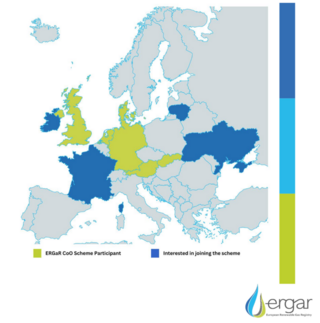ERGaR (European Renewable Gas Registry)
ERGaR (European Renewable Gas Registry) was founded as a cooperation between the national renewable gas registries in Europe to enable the cross-border transfer of renewable gas certificates between member registries.
The association currently has 40 members from 14 European countries, including established biomethane/renewable gas registries, gas DSOs & TSOs, biogas associations and the most important players in the European biomethane market.

Renewable gases and biomethane
Renewable gases are expected to play a key role in achieving the European energy and climate targets. In particular, feeding them into natural gas grids is expected to be an important driver of the energy transition towards a CO₂-free society.
With more than 500 biomethane plants producing around 17 TWh (source: EBA, 2018, EBA 2018 statistical report, data as at the end of 2017), biomethane is already the green element of the gas business. More than 17,000 biogas plants in Europe represent a significant potential for biomethane in the near future.
Biomethane is biogas upgraded to natural gas quality. The aim of the cooperation is to create an independent, transparent and trustworthy documentation system for the mass balancing of renewable gas distributed via the European natural gas grid.
The task of the European Renewable Gas Registry
ERGaR will be the Europe-wide recognized organization for the management and mass balancing of volumes of renewable gases distributed virtually along the European gas grid. The organization will bring together the expertise of national renewable gas registries to issue and cancel Guarantees of Origin for commodities with export destinations on a common basis.
Renewable gases in the future
By 2050, renewable gas, such as biomethane, will be produced in thousands of new plants using updated and new technologies from all types of organic waste, by-products and other renewable feedstocks. Renewable gas will provide the green component of the fuel blend with natural gas, which will be distributed through the European gas grid and used in all European countries to generate electricity, for heating and cooling, and as a biofuel in the transport sector.